25+ Performance Goals Examples to Drive Employee Growth
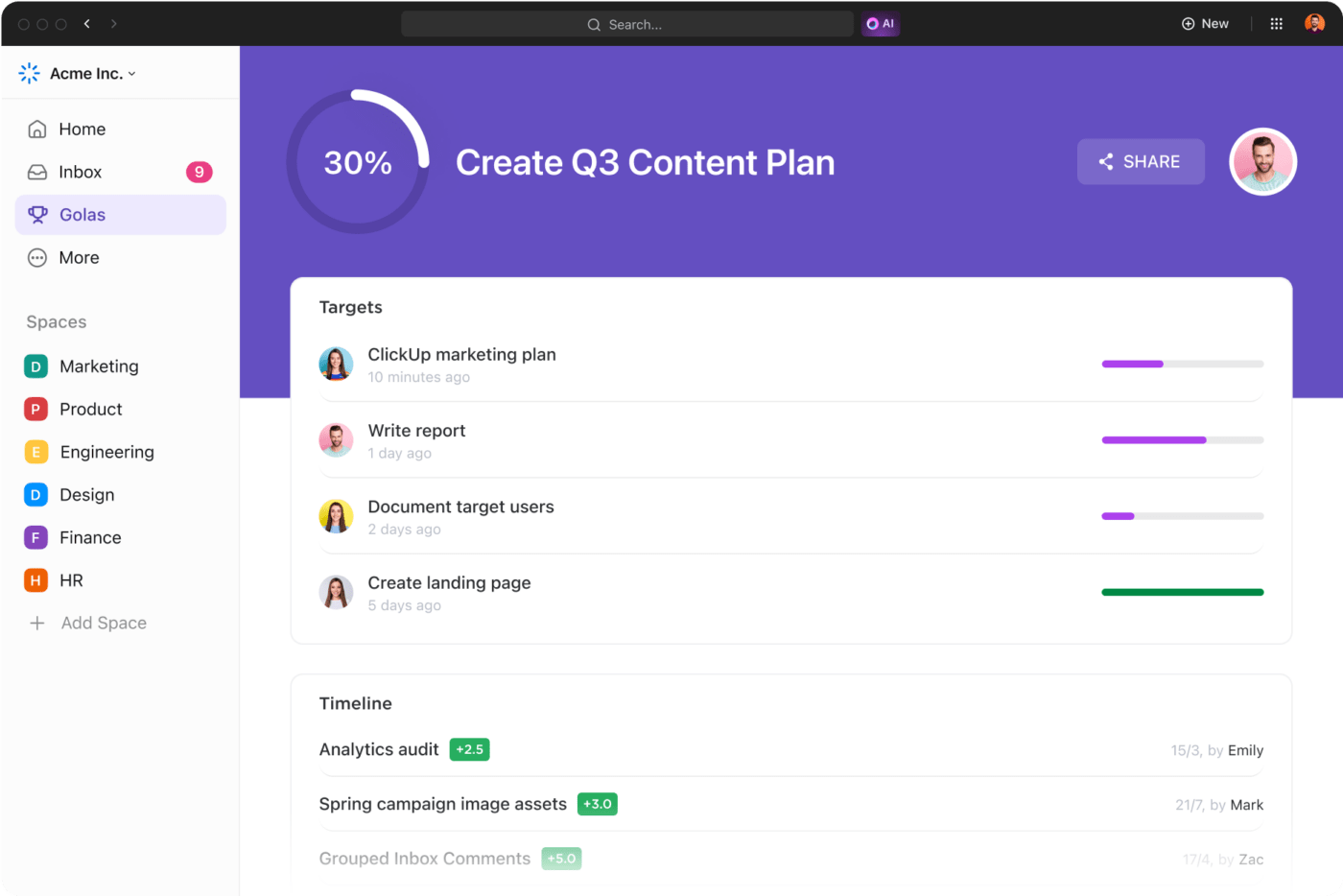
Sorry, there were no results found for “”
Sorry, there were no results found for “”
Sorry, there were no results found for “”

A performance review rolls around. Your employee’s been working hard. But when it’s time to talk about professional growth, there’s not much on paper to show for it.
It’s not a leadership failure; it’s a common challenge. Without well-defined performance goals, development conversations can feel vague or even unfair.
The good news? Setting meaningful employee goals isn’t complicated.
In this blog post, we’ll break down 25+ performance goals examples. You’ll learn how to create goals that align employees’ personal progress with company priorities, and how tools like ClickUp make it easy to keep those goals in sight all year long. 🎯
Performance goals are clear, measurable objectives set for employees that focus on specific duties or tasks within their job roles.
These goals help them understand what is expected of them, align their efforts with organizational priorities, and improve their effectiveness.
But what makes a good employee performance goal? Whether a goal is focused on improving collaboration, accountability, soft skills, or other aspects, it will have some typical characteristics. 👇
📖 Also Read: Goal Setting for Performance Review Appraisal
The right performance goals for a specific employee will depend on what they do, how their work supports the bigger picture, and where they should focus their efforts.
Here are some examples of performance goals tailored to various roles and functions, designed to drive organizational success. 💁
Here are some professional goals for work:
🧠 Fun Fact: Frederick Winslow Taylor, known as the father of scientific management, introduced principles in the early 1900s that emphasized efficiency and productivity, laying the groundwork for modern performance management systems.
🔍 Did You Know? According to the Hawthorne effect, workers’ productivity increased when they knew they were being observed, highlighting the psychological aspects of performance management.
🧠 Fun Fact: The roots of performance management go way back; some historians trace it to 221 AD, when emperors of the Wei Dynasty reportedly rated their family members’ everyday performance.
💡 Pro Tip: Create a performance review plan for your sales team with a layer of fun by gamifying sales performance goals. Use leaderboards, badges, or small rewards for hitting key performance metrics like calls made, deals closed, or upsells.
📖 Also Read: Performance Review Tips for Employees: A Guide
Let’s explore how to set realistic goals that are clear, actionable, and aligned with your team’s objectives while also meeting individual professional development needs. 🎯
If you’ve ever googled how to set goals, you’ve probably come across SMART goals. But here’s the thing: they’re everywhere because they work. See how:
Before locking in a goal, run it through a SMART filter. Write it out, and mark off each letter. It’s a quick check that saves time later.
💡 Pro Tip: With ClickUp Goals, you can create measurable, trackable objectives and share them with all relevant team members. Break those down into smaller, actionable targets, assign owners, set deadlines, and ClickUp tracks progress automatically. Visual progress bars keep everything transparent, so you’ll always know who’s on track and who might need a nudge.
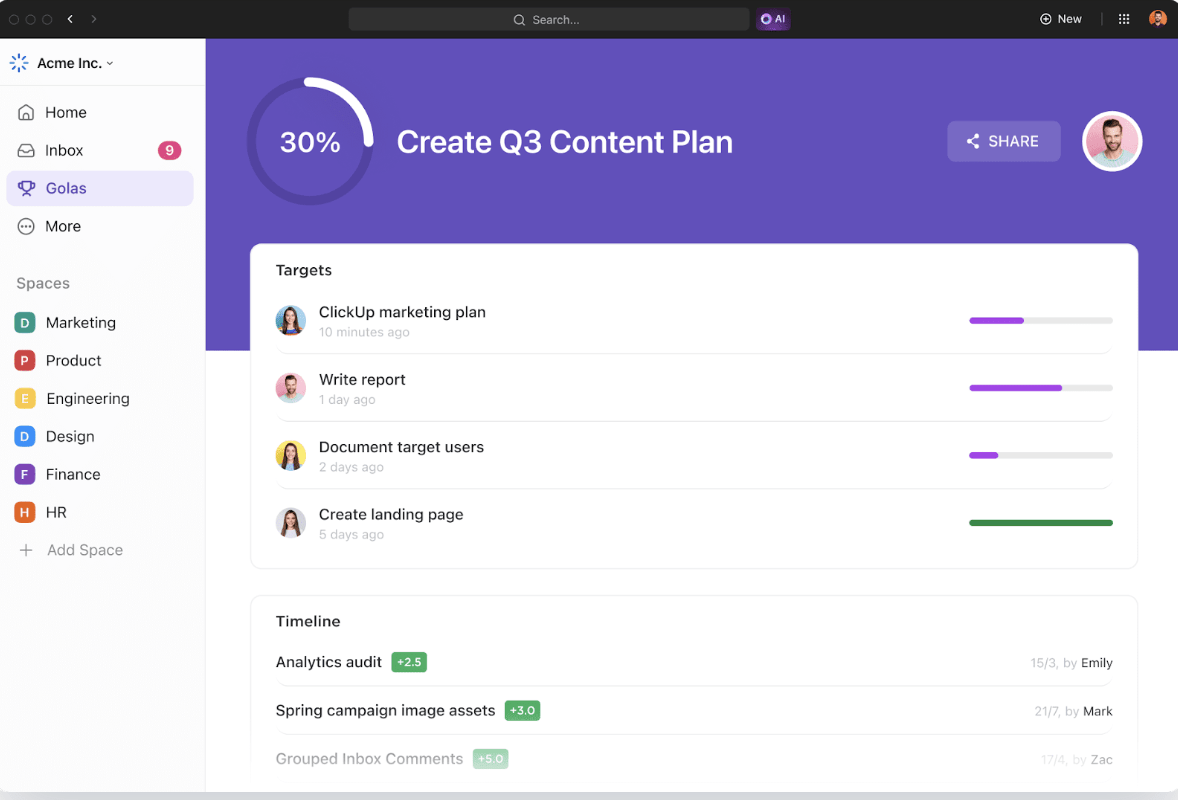
And if you don’t want to start it all from scratch?
Use ClickUp Templates.
ClickUp’s SMART Goals Template offers a visual way to set and manage goals without second-guessing.
This template organizes goals by status, including Crushing, On-Track, Off-Track, and To-Do. Customize each goal by adding details such as the target outcome, the people involved, due dates, and the effort required (visually represented in a color-coded scale).
You can also access a KPI dashboard to show these metrics.
Think of company Objectives and Key Results (OKRs) or KPI examples as the GPS. If your team’s personal goals aren’t headed in the same direction, you’re going to miss the destination.
Review your company’s top OKRs or KPIs for the quarter and then ask yourself, ‘What can my team do that directly helps hit these targets?’
For instance, if your organizational objective is to expand into a new region, your professional goal for work might be ‘Close five new deals in Region X by the end of Q2.’
Teams often struggle to stay aligned on long-term objectives. The ClickUp OKRs Template organizes your objectives and key results by quarter, showing exactly where each objective stands (from Not Started to Complete), who owns it, and how it ties into larger initiatives like product innovation or customer retention.
Each item is color-coded for clarity and includes built-in progress bars, allowing leadership and teams to identify risks (At Risk, Off Track) before they escalate.
💡 Pro Tip: Keep a shared doc or dashboard that shows how everyone’s goals ladder up to company OKRs. A shared performance review template builds team momentum and makes it easier to spot overlapping efforts or gaps.
This is a big one. Goals are way more powerful when the person owning them helps shape them. When employees feel like they own the goal, they’re more motivated to hit it.
Here’s how to collaborate:
💡 Pro Tip: Performance reviews, goal conversations, and feedback often get buried in emails. ClickUp Docs gives you a centralized space to document review templates, track conversations, and link goals directly inside the doc. You can comment, tag teammates, and even embed task progress in real time.
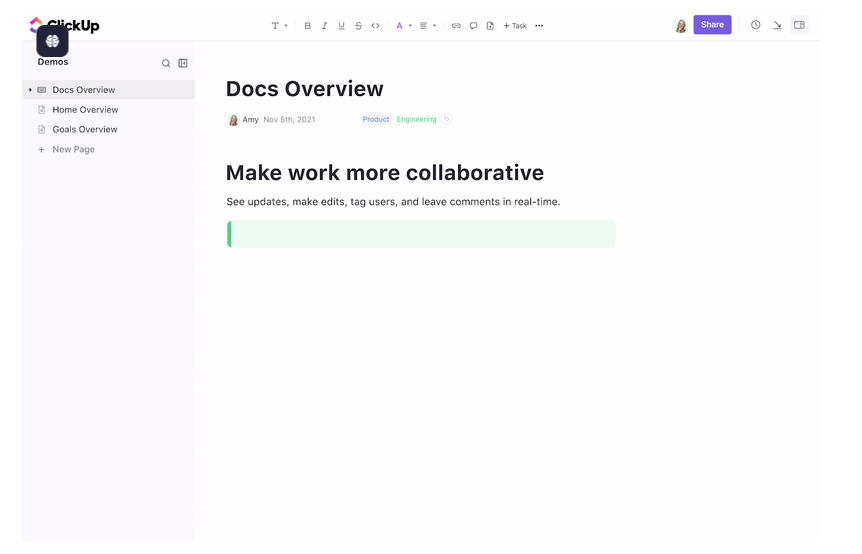
Setting goals is step one. But if you’re not tracking progress consistently, they’ll get buried under daily chaos. A performance management tool like ClickUp helps turn ‘someday’ goals into something you see (and act on) every day.
💡 Pro Tip: Say you’re a team lead managing multiple KPIs, say, average task completion time, sales targets, or support ticket volume. ClickUp Dashboards let you see it all in one view. You can add custom cards for every metric, including burndown charts and workload balance.
And to tie it all together, ClickUp Integrations connects your external tools, including CRM, calendar, and HR platforms, so your goals stay in sync with work actually getting done.
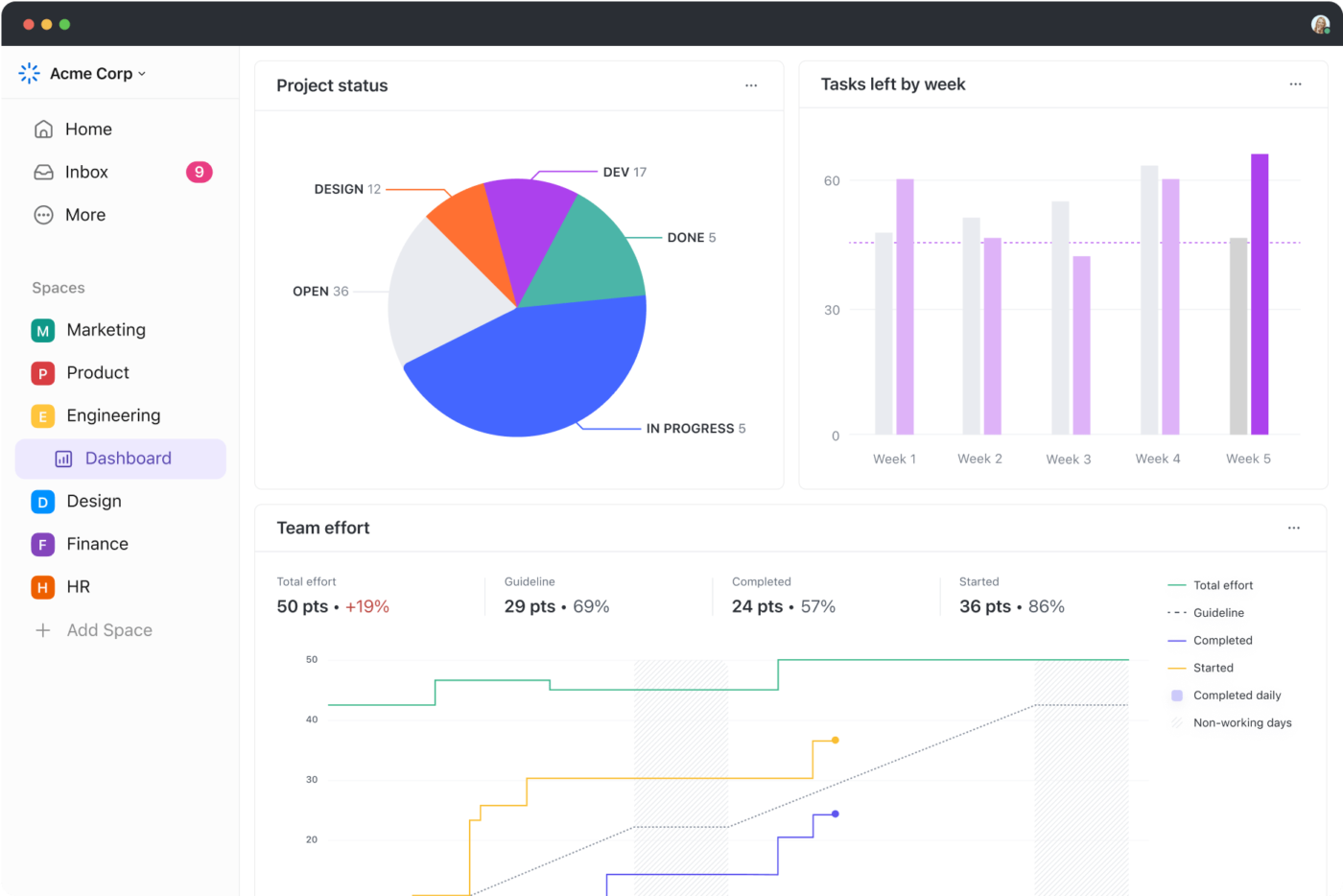
🧠 Fun Fact: In the 1970s, Peter Drucker introduced Management by Objectives (MBO), kicking off an era of goal-setting and progress tracking. By the ’80s and ’90s, it was all about performance appraisals and formal constructive feedback.
Here are some useful tips to keep in mind when setting performance goals for employees and teams:
💡 Pro Tip: ClickUp Brain summarizes performance highlights and generates coaching points based on personal growth sprint history. This facilitates continuous performance management.
Plus, you can ask its AI Writer to write performance reviews in a professional tone. Tailor the structure based on the employee’s role, seniority, or development plan, keeping feedback clear, consistent, and actionable.
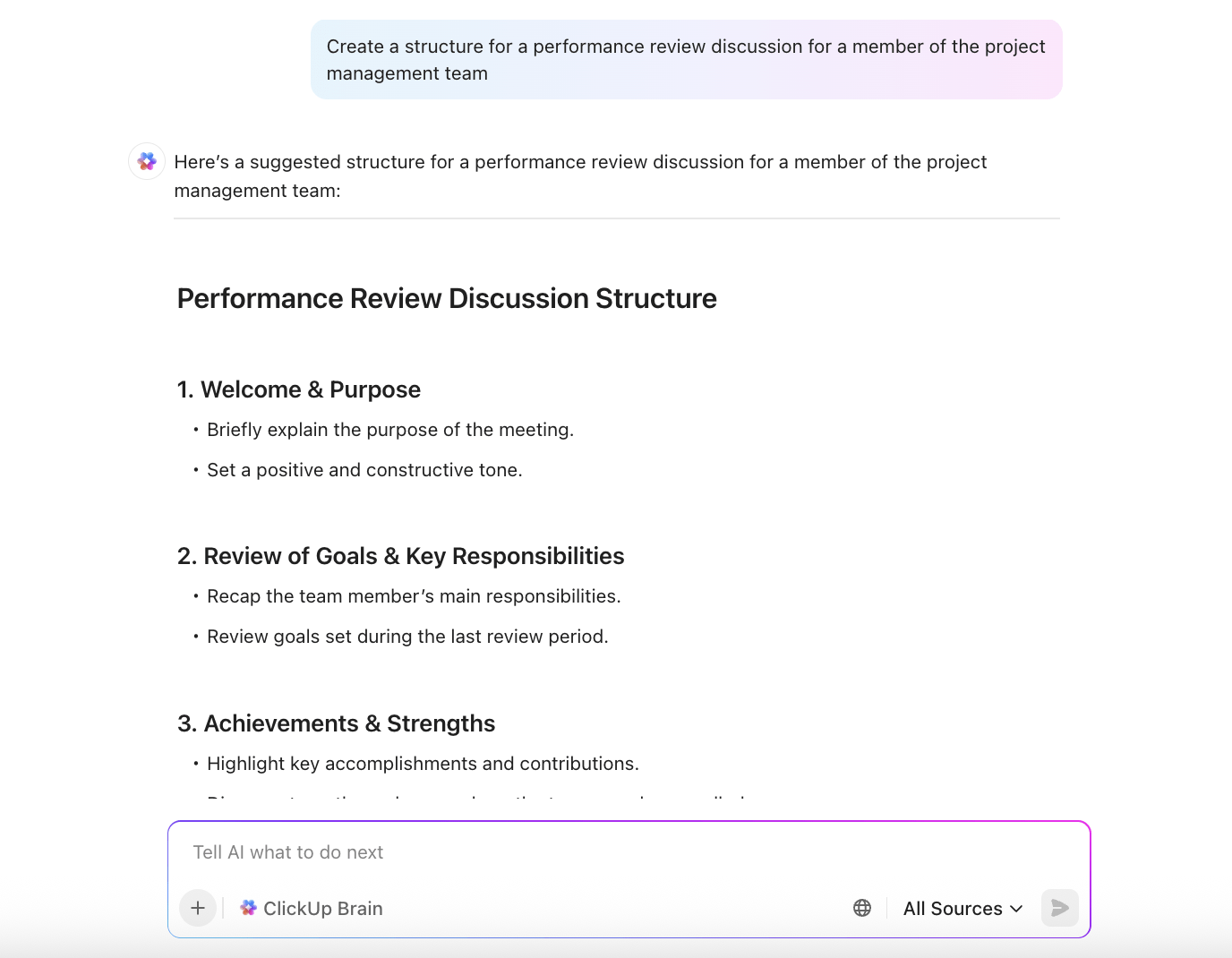
📖 Also Read: Process Improvement Templates to Enhance Efficiency
📮 ClickUp Insight: 63% of our survey respondents rank their personal goals by urgency and importance—but only 25% organize them by timeframe.
Meaning? You know what matters, but not necessarily when. ⏳
ClickUp Goals, enhanced by ClickUp Brain’s AI assistance, brings clarity here. It helps you break down large professional development goals into time-bound, actionable steps. ClickUp Brain provides intelligent suggestions for timelines and keeps you on track with real-time progress updates and automatic status changes as you complete tasks.
💫 Real Results: Users report a 2x boost in productivity after switching to ClickUp.
Setting goals is important, but achieving them is where the real work and growth happen. For this, you need more than just a shared doc. You require structure, visibility, and accountability.
ClickUp makes a big difference here.
With ClickUp Goals, you can set clear, measurable objectives, while customizable dashboards help you gain real-time visibility. Want everything in one place? Pull in updates from your CRM, time tracker, or communication tool with its powerful integrations.
Sign up to ClickUp for free today! ✅
Performance goals for project managers can be grouped across project delivery, process improvement, stakeholder management, professional development, and team collaboration. Examples of each can be:
– Deliver 90% of projects on time and within budget by the end of the year
– Reduce average project cycle time by 20% in the next two quarters
– Provide project status reports with >95% accuracy and timeliness
– Improve project management skills with a new certification (e.g., PMP, PRINCE2, Agile) within the year
– Increase cross-functional collaboration by running at least 3 joint workshops per quarter
Performance objectives for startups focus on agility, growth, and resource optimization. Some examples of such goals are:
– Increase monthly recurring revenue (MRR) by 20% within the next two quarters
– Launch the MVP within 90 days with at least 3 core features
– Acquire 500 new qualified leads per quarter through organic and paid channels
– Increase employee engagement score by 15%
– Secure $1M in seed funding within the next 9 months
Employee performance goals can be measured effectively by using dashboards, scorecards, or performance tracking tools like ClickUp. Combine numbers with qualitative insights, gather relevant feedback from the entire team, and regularly realign goals to match changing business priorities.
© 2025 ClickUp